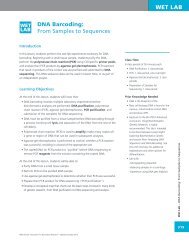LESSON 4 Using Bioinformatics to Analyze Protein Sequences
LESSON 4 Using Bioinformatics to Analyze Protein Sequences
LESSON 4 Using Bioinformatics to Analyze Protein Sequences
You also want an ePaper? Increase the reach of your titles
YUMPU automatically turns print PDFs into web optimized ePapers that Google loves.
<strong>LESSON</strong> 4ResourcesThe Howard Hughes Medical Institute (HHMI) Biointeractive site offers a variety of freely-available videos and animations.The following animations may be of particular interest for this lesson:• DNA Transcription (basic detail, 1:54 minutes):http://www.hhmi.org/biointeractive/dna/DNAi_transcription_vo1.html• DNA Transcription (advanced detail, 1:55 minutes):http://www.hhmi.org/biointeractive/dna/DNAi_transcription_vo2.html• Translation (basic detail, 1:48 minutes):http://www.hhmi.org/biointeractive/dna/DNAi_translation_vo1.html• Translation (advanced detail, 1:48 minutes):http://www.hhmi.org/biointeractive/dna/DNAi_translation_vo2.html• Coding <strong>Sequences</strong> in DNA (1:04 minutes):http://www.hhmi.org/biointeractive/dna/DNAi_coding_sequences.htmlFor more information about DNA sense and anti-sense strands, seeWikipedia: http://en.wikipedia.org/wiki/Sense_(molecular_biology).Dr. Crawford and his collabora<strong>to</strong>rs recently published a study in Nature detailingthe sequencing and analysis of DNA isolated from a 4,000-year-old sample.Sequencing of the Y-chromosome confirmed that the remains were male, likelyone of the first settlers of the New World Arctic (northern Alaska, Canada,and Greenland). Also among their findings: the man from whom the DNA wasisolated had type A+ blood; likely had brown eyes, dark hair, and darker skin; hadan increased risk of baldness; and had a dry earwax type more typical of Asiansand Native Americans than the wet ear wax type of other ethnic groups. Studentsmay recall discussions of genetic testing and ear wax type in Lesson One of theBio-ITEST Introduc<strong>to</strong>ry unit, <strong>Using</strong> <strong>Bioinformatics</strong>: Genetic Testing, when theyexplored the Direct-<strong>to</strong>-Consumer (DTC) genetic testing company 23 and Me.23 and Me, as well as other DTC companies, also offer tests for increased risk ofbaldness. You can read more from the article (Rasmussen et al., 2010) in the free,full-text article available from Nature at: http://www.nature.com/nature/journal/v463/n7282/full/nature08835.html.CreditCrawford, Michael. Personal Interview. 19 March 2010.Direct-<strong>to</strong>-Consumer (DTC) genetictesting: Sometimes referred <strong>to</strong> asat-home genetic testing, direct-<strong>to</strong>consumergenetic tests are genetictests marketed directly <strong>to</strong> the consumerwithout necessarily involving a doc<strong>to</strong>r orinsurance company.Rasmussen et al. Ancient human genome sequence of an extinct Palaeo-Eskimo. Nature. 2010; 463: 757–762.The circular format codon table was adapted from: Elling<strong>to</strong>n, A., & Cherry, J.M. (1997). Characteristics of Amino Acids.In F.M. Ausubel, D. Moore, D.D. Moore, R. Brent and J.G. Seidman (Eds.), Current Pro<strong>to</strong>cols in Molecular Biology(pp. A.1C.1–A.1C.12). Hoboken, NJ: John Wiley & Sons, Inc.Lesson 4 – <strong>Using</strong> <strong>Bioinformatics</strong> <strong>to</strong> <strong>Analyze</strong> <strong>Protein</strong> <strong>Sequences</strong>141©Northwest Association for Biomedical Research—Updated Oc<strong>to</strong>ber 2012
















